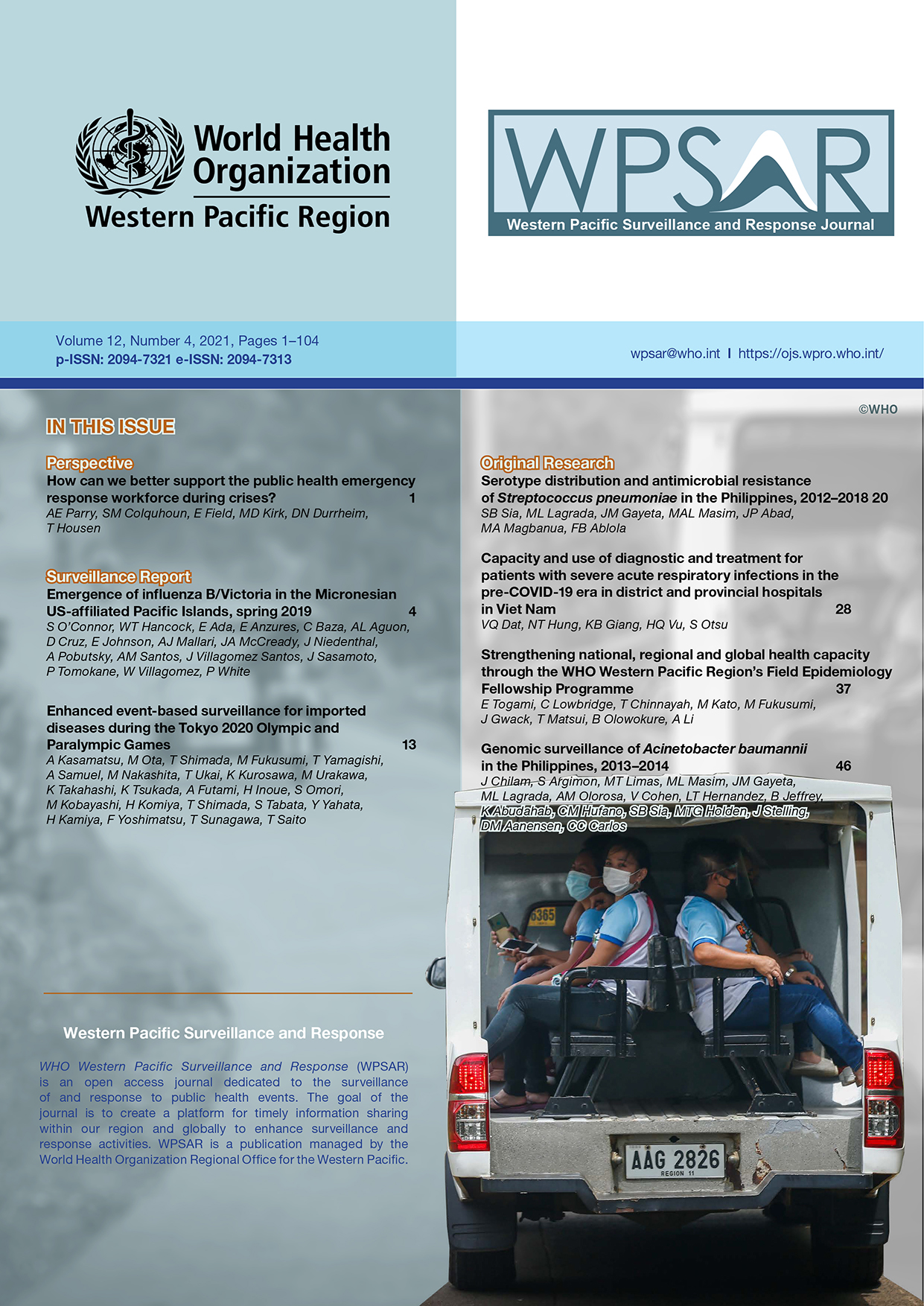Emergence of influenza B/Victoria in the Micronesian US-affiliated Pacific Islands, spring 2019
DOI:
https://doi.org/10.5365/wpsar.2021.12.4.706Abstract
Data collected through routine syndromic surveillance for influenza-like illness in the Micronesian United States-affiliated Pacific Islands highlighted out-of-season influenza outbreaks in the spring of 2019. This report describes the data collected through the World Health Organization’s Pacific Syndromic Surveillance System for the Commonwealth of the Northern Mariana Islands (CNMI), Guam, the Federated States of Micronesia (FSM) and the Republic of the Marshall Islands (RMI). Compared with historical data, more cases of influenza-like illness were observed in all four islands described here, with the highest number reported in Guam in week 9, CNMI and FSM in week 15, and RMI in week 19. The outbreaks predominantly affected those aged <20 years, with evidence from CNMI and RMI suggesting higher attack rates among those who were unvaccinated. Cases confirmed by laboratory testing suggested that influenza B was predominant, with 83% (99/120) of subtyped specimens classified as influenza B/Victoria during January–May 2019. These outbreaks occurred after the usual influenza season and were consistent with transmission patterns in Eastern Asia rather than those in Oceania or the United States of America, the areas typically associated with the United States-affiliated Pacific Islands due to their geographical proximity to Oceania and political affiliation with the United States of America. A plausible epidemiological route of introduction may be the high levels of international tourism from Eastern Asian countries recorded during these periods of increased influenza B/Victoria circulation. This report demonstrates the value of year-round surveillance for communicable diseases and underscores the importance of seasonal influenza vaccination, particularly among younger age groups.
References
Kool JL, Paterson B, Pavlin BI, Durrheim D, Musto J, Kolbe A. Pacific-wide simplified syndromic surveillance for early warning of outbreaks. Glob Public Health. 2012;7(7):670-81.
Flahault A, Dias-Ferrao V, Chaberty P, Esteves K, Valleron AJ, Lavanchy D. FluNet as a tool for global monitoring of influenza on the Web. Jama. 1998;280(15):1330-2.
Socan M, Prosenc K, Ucakar V, Berginc N. A comparison of the demographic and clinical characteristics of laboratory-confirmed influenza B Yamagata and Victoria lineage infection. Journal of clinical virology : the official publication of the Pan American Society for Clinical Virology. 2014;61(1):156-60.
Barr IG, Vijaykrishna D, Sullivan SG. Differential age susceptibility to influenza B/Victoria lineage viruses in the 2015 Australian influenza season. Euro surveillance : bulletin Europeen sur les maladies transmissibles = European communicable disease bulletin. 2016;21(4).
Vijaykrishna D, Holmes EC, Joseph U, Fourment M, Su YC, Halpin R, et al. The contrasting phylodynamics of human influenza B viruses. eLife. 2015;4:e05055.
El Guerche-Seblain C, Caini S, Paget J, Vanhems P, Schellevis F. Epidemiology and timing of seasonal influenza epidemics in the Asia-Pacific region, 2010-2017: implications for influenza vaccination programs. BMC Public Health. 2019;19(1):331.
World Health Organization Global Influenza Surveillance and Response System. Influenza Laboratory Surveillance Information, United States of America, 2019 Week 1-20. 2019.
World Health Organization Global Influenza Surveillance and Response System. Influenza Laboratory Surveillance Information, Oceania Melanesia Polynesia Influenza Transmission Zone, 2019 Week 1-20. 2019.
World Health Organization Global Influenza Surveillance and Response System. Influenza Laboratory Surveillance Information, Western Pacific Region of WHO, 2019 Week 1-20. 2019.
Guam Visitors Bureau. May 2019 Arrivals. 2019.
Marianas Visitors Authority. Visitor Arrival Statistics 2019 [Available from: https://drive.google.com/file/d/1At2CnRpMpM5q-9pvd6eqNkZoYlJjA8Tk/view.
World Health Organization Global Influenza Surveillance and Response System. Influenza Laboratory Surveillance Information, Eastern Asia Influenza Transmission Zone, 2019 Week 1-20. 2019.
Office of Commerce, Investment and Tourism. OCIT Progress Report: January to March 2019. 2019.
Office of Commerce, Investment and Tourism. Tourism Sector Profile: Marshall Islands. 2019.
FSM Division of Statistics. International Visitor Arrival Detailed Table 2016 [Available from: http://www.fsmstatistics.fm/?page_id=257.
World Health Organization. Recommended composition of influenza virus vaccines for use in the 2018-2019 northern hemisphere influenza season. 2018.

